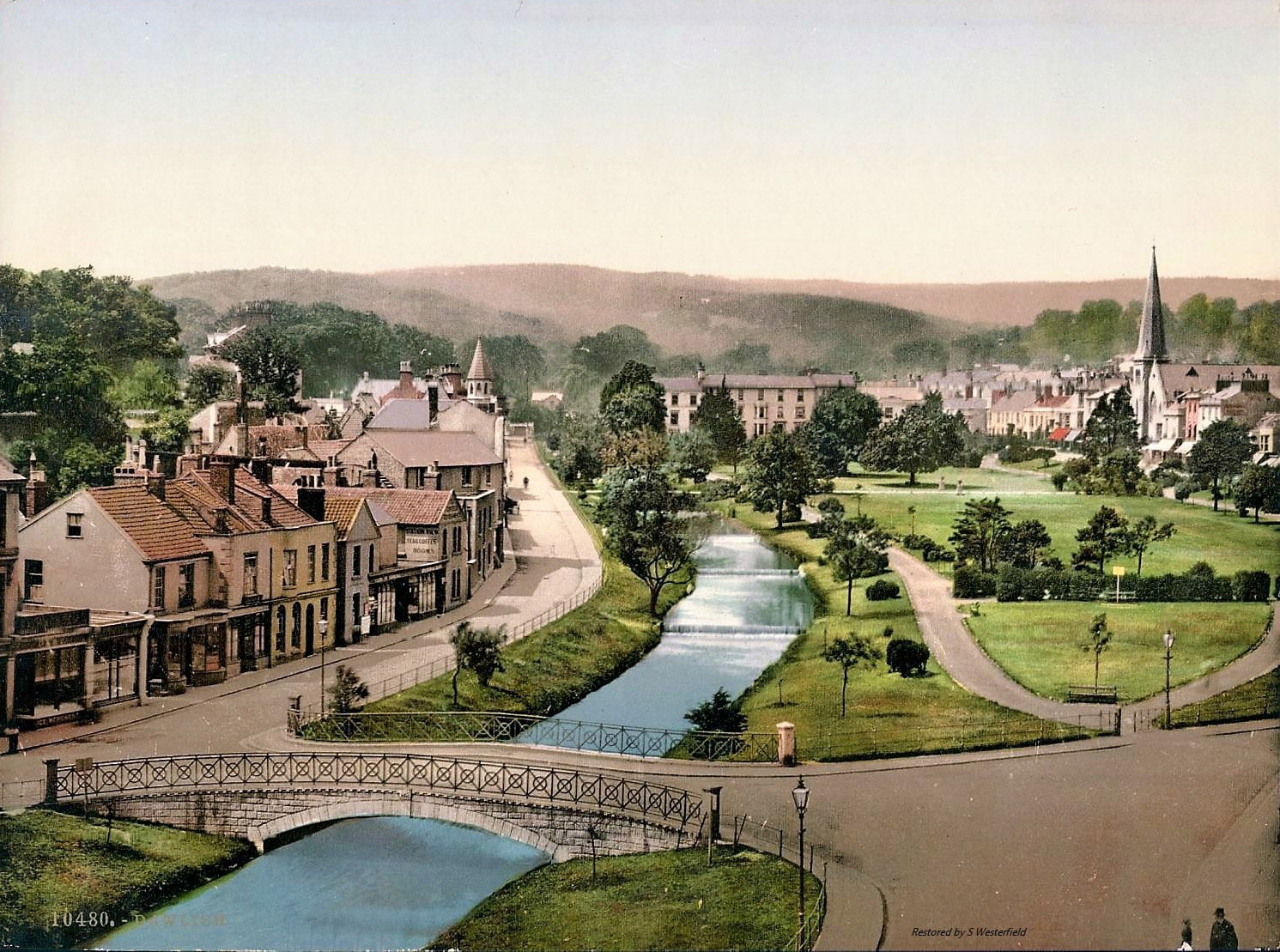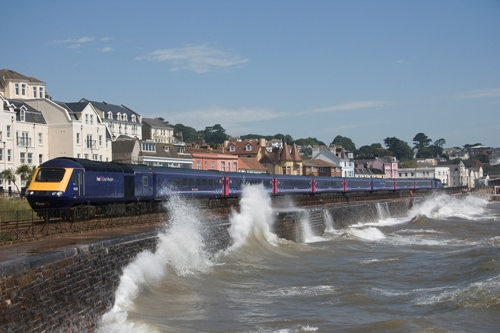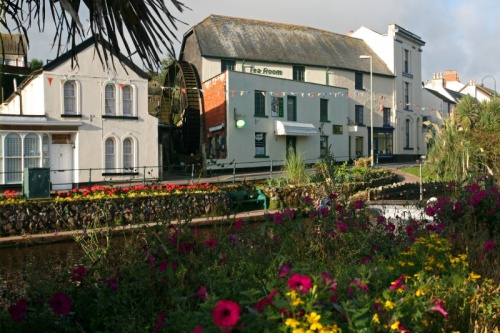
“Reaching down where the fresh and salt water meet,
The Roofs may be seen of an old-fashioned street,
Half village, half town, it is pleasant and smallish,
And known, where it happens to be known, as Dawlish.”
R.H.D. Barham (1880)



Bird watching colonels on the old sea wall
Down here at Dawlish, where the slow trains crawl
Low tide lifting, on a shingle shore
Long-sunk islands from the sea once more
Red cliffs rising where the wet sands run
Gulls reflecting in the sharp spring sun
Pink-washed plaster by a sheltered patch
Ilex shadows upon velvet thatch
What interiors these names suggest
Queen of lodgings in the warm south-west
Sir John Betjeman 1906 - 1985
1044 First mention of Dawlish (Doflisc) in the Charter of 1044 with corresponding boundaries. King Edward the Confessor grants manor of Dawlish to his Chaplain, a man known as Leofric
1069 William I made a grant of land to the church of St. Peter at Exeter and this grant included 'Holcombe'. The land at Dawlish is mentioned as well as Holcombe and Southwood
1072 Manor of Dawlish bequeathed to the Church which remains under Church ownership until 1807.
1086 Domesday Survey. Dawlish (recorded as Doules) remains annexed to See of Exeter
1148 First mention of a church at Dawlish
1253 Dawlish known as Douelis
1284 Dawlish known as Douelys
1348 The Plague or Black Death recorded, including deaths of at least 3 priests
1411 Dawlish known as Douelysh
1426 Dawlish know as Douelyssh
1536 Dawlish known as Douelyshe
1555 Dawlish known as Dulishe
1607 Dawlish known as Dulyshe
1629 The Plague returns until 1630
1640 Manor of Dawlish let on lease to raise funds for Charles I
1655 Sir Peter Balle is mentioned as Lord of the Manor and holder of the great tithes
1717 A mill is recorded on the rent book, probably just constructed at Brunswick Place (now The Old Mill Tea Room) mainly to produce flour
1733 New flour mill constructed known as Town Mill at Church Street
1791 Dawlish known as Dalditch
1793 Bridge House constructed
1795 First large residential house built in the Old Town, followed by Brook House and later known as New Bridge House
1797 Dawlish now known as Dawlish
1799 A letter-receiving office opens in Dawlish
1803 Land improved either side of the Brook, with stream straightened, banks built up and marshy land drained
1806 First shop recorded in the rent book at Weech Road
1810 Serious flooding washes away newly created lawns, banks and bridges. All rebuilt with series of weirs to prevent a recurrence
1811 A new mansion built known as The Manor House
1814 Independent Chapel built in Chapel Street
1817 First fire engine purchased
1819 New poor houses erected
1820 School erected in the workhouse yard
1824 St Gregory's Church rebuilt
1825 The flour mill at Brunswick Place is rebuilt, following a fire. Although primarily a flour mill, it is now also used to produce animal feeds. A potato store is added to the front of the building (now the Old Mill Tea Room)
1828 Baths built at Marine Parade
First Post Office opens in Mill Row (now Brunswick Place)
1844 South Devon Railway buys almost all properties in Marine Parade including Great Cliff House (formerly Kennaway's House), to buy out opposition to the railway . SDR uses Great Cliff House as offices and as a meeting place for Directors, property let to Joeseph Samuda (Patentee of the Atmospheric Railway), to supervise construction.
1846 Broad Gauge Railway opens at Dawlish Saturday, 30th May first train from Exeter to Teignmouth via Dawlish with 9 coaches
1847 First Atmospheric trains start to run in February but no public service trains until 13th September
1848 Last Atmospheric train runs on Saturday 9th September; replaced by steam locomotives . South Devon Railway begins to sell off properties in Marine Parade, including Great Cliff House, which is then occupied by private residents for the next 100 years
1857 Police force established to support Parish Constable
1860 "Dawlish Cider" made from locally grown apples - business lasts until 1962
1861 The Wesleyans open new Methodist Chapel in Brunswick Place
1868 Coastguard Station built
1870 York Inn demolished in the Strand, in favour of the Congregational Church in Gothic style
1873 Original Dawlish Station destroyed by fire
1875 Dawlish Station rebuilt
1879 Cast iron footbridge added from sea wall across to Marine Parade
1885 Large rock fall at West Cliff – cliff face then “sloped”.
1880 Ladies bathing pavilion opened on the main beach (gents bath at Coryton Beach)
1884 Dawlish Cemetery & Mortuary Chapel built
1887 The Dawlish Corps formed
1890 Mail catching device in use at Dawlish Station
1892 Last Up and Down Broad Gauge trains run on Friday 20th May, both passing each other at Dawlish Station. Line converted to Standard Gauge.
1893 First telephone exchange opened
1895 Baths on Marine Parade substantially altered - to become a gentlemen's club
1897 Extensive alterations made to St Gregory's Church - interior & exterior
1900 First trial and naming of Dawlish horse-drawn fire pump on 5th April
1901 Sea Wall widened by 18ft to enable construction of last section of double track from Dawlish to Parson's (completed in 1905). The new wall has a dramatic effect on lowering the beach level. The sub-way from the beach to Marine Parade is reconstructed.
1907 New fishermen's shelter opened at Boat Cove - lasts until 1937
1908 Post Office & Telegraph Office saved by firemen on 21 August
Nos 1 & 2 Sea Lawn properties gutted by fire on 22 December
1909 St Agatha's Roman Catholic Church completed in Exeter Road
1911 Walford's Cinema opens in Chapel Street
Two more bells added at St Gregory, in commemoration of George VI's coronation
1914 Restoration of the original Dawlish fire pump completed, for display
1918 Bridge House taken over by GWR as a railway convalescent home in July
1929 GWR builds Haldon Aerodrome for flights to Torbay, Cardiff & Plymouth
1930 Motor fire engine purchased
1935 Extensive playing fields opened, with 2 football pitches, a hockey/cricket pitch, bowling green, hard & grass tennis fields, children’s playing area and car park
1937 New fishermen's shelter built at Boat Cove
1940 Improved water supplies from the Haldon Hills completed
1941 Automatic telephone exchange installed
1942 Herbert Brooks Hancocke moves to Hope Cottage, Dawlish, prior to his retirement as Chief Boiler Inspector for the Great Western Railway in 1945 - later to become the Chairman of Dawlish Town Council.
1943 B17F Flying Fortress crash lands in field near Langdon Hospital, damaged by flak. Later repaired with 3 new engines and flown out
1945 Victory Tea celebrations held
1946 The Manor House purchased by Dawlish Urban District Council. The whole house was used as new Offices for the Council and the Gardens opened to the public
1947 Black Swans introduced from the Taronga Zoo, Sydney, by Captain C.R.S. Pitman
1950 Great Cliff House combined with 2 or 3 other properties in Marine Parade to form The Great Cliff Hotel.
1952 Sub-way to Marine Parade filled in – slight protrusion marks site
1954 Herbert Brooks Hancocke Chairman of Dawlish Town Council
1955 Fire destroys 6 bedrooms at Mount Pleasant Inn
1959 The Shaftsbury Theatre constructed by The Repertory Company with seating for 170
The mill at Brunswick Place closes. (Later restored to become The Old Mill Tea Room).
1962 Deep snow and freezing temperatures closes roads and schools
Dawlish cider-making business closes
1965 New concrete footbridge from sea wall to Marine Parade replaces cast iron bridge
1971 The Great Cliff Hotel becomes The Great Cliff Hotel for Residents
1974 The Manor House taken over by Teignbridge District Council and rooms were let out. The building eventually falls into disrepair but bought back by Dawlish Town Council
1980 Dawlish Town Council reopens The Manor House, following extensive renovation
2004 The huge wheel at The Old Mill is restarted on 5th May by the Mayor of Dawlish, Cllr Bill Farrow, with the wheel pumps turned on by Mr Bill Strickland, who turned it off 45 years ago when he worked at the mill.
2005 The Great Cliff Hotel for Residents is demolished
2006 23 new luxury apartments built on site of The Great Cliff Hotel, now known as Great Cliff
1835 First serious proposals made for a railway to run from Exeter to Plymouth
1836 Brunel survey’s a route across South Devon (preferring to tunnel behind Dawlish & Teignmouth to avoid a sea wall)
1843 Resurvey carried out by Brunel
Great Western Railway and Bristol & Exeter Railway agree to provide large share of Capital
South Devon Railway deposits its plans
Isambard Kingdom Brunel appointed Engineer for the South Devon Railway
Considerable opposition on environmental grounds, especially at Dawlish
1844 All objections referred to the Admiralty Engineer, James Walker
SDR received its Act in July, just after completion of line from London (Paddington) to Exeter
Construction commences with completion objective of July 1845, with 2,000 workmen known as “navies” employed
SDR buys almost all properties in Marine Parade, Dawlish to buy out opposition and uses a house (now the site of Great Cliff) for Board Meetings for several months
SDR Directors agree to adopt the Atmospheric system following a visit to Dalkey, near Dublin but would not be operational until 1847
1845 Many problems experienced in building the sea wall
Sea Wall at Dawlish built with sub-way from the beach to Marine Parade
Track-laying commences on Broad Guage
16th December first SDR test run from Exeter to Cockwood and back
Boathouse footbridge built
1846 Track laid as far as Teignmouth, through Dawlish
Gradient from Dawlish Station past Marine Parade has a steep gradient of 1 in 30 to avoid spoiling residents’ sea views (now 1 in 96)
5 tunnels built – Kennaway, Coryton, Phillot, Clerk’s and Parson’s (first three are named after the landowners; last two named after the famous rocks)
Temporary timber station built at Dawlish – lasts for 27 years!
Work starts on the Engine House at Dawlish for the new Atmospheric Railway
Saturday, 30th May first train from Exeter to Teignmouth via Dawlish with 9 coaches hauled by locomotives Exe and Teign (renamed Viper for the event), hired from the GWR by the SDR
4,000 tickets sold at Teignmouth on the Bank Holiday Monday, many to Dawlish
Trains take 45 mins to travel from Teignmouth to Exeter with 7 trains each way
Teignmouth to London takes an unprecedented time of 5 hours 20 mins
31st December line opens as far as Newton Abbot
Sea breaches line near Breeches Rock
1847 First Atmospheric trains start to run in February but no public service trains until 13th September
Icy weather disrupts services with valves not closing properly
1848 Whole service is Atmospherically worked as from February
Hot weather during summer causes valves to dry and tear
Half year accounts for Atmospheric Railway show a loss & Shareholders vote to abandon the system in August
Last Atmospheric train runs on Saturday night 9th September, returning to steam locomotives.
SDR begins to sell off properties in Marine Parade
Fares increase & public enthusiasm destroyed until lowered in 1850’s
1852 Exminster Station opened
1853 Railway bridge at Holcombe destroyed in a storm
1855 Sea breaches line at Smugglers’ Lane
1869 Sea breaches line at Sea Lawn
High level footway on sea wall extended eastwards from Coastguard footbridge
1870 Footbridge constructed at Rockstone (known as Black Bridge locally)
1872 Sea breaches line at Rockstone
1873 Original Dawlish Station destroyed by fire
Doubling of line through Dawlish Warren
Line slewed inland at Langstone rock
Footbridge at Langstone Rock removed
Footbridge built at Dawlish Warren
GWR agrees with Dawlish Local Board to provide a public footway along the sea wall when the line is doubled
1874 Line doubled from Starcross to Dawlish
1875 Dawlish Station rebuilt
1876 South Devon Railway taken over by the Great Western Railway
1879 Cast iron footbridge added from sea wall across to Marine Parade
1884 Signal box built at Parson’s Tunnel
Line doubled west of Parson’s Tunnel
1885 Large rock fall at West Cliff – cliff face then “sloped”.
1892 Last Up and Down Broad Gauge trains run on Friday 20th May, both passing each other at Dawlish Station
First Standard Gauge Down test train leaves Exeter on Saturday 21st May at 5.30am and passes Dawlish at 1.15pm on way to Newton Abbot
Normal service with Standard Gauge resumes on Monday, 23rd May
1901 Work starts on replacing the Sea Wall at Dawlish – 18ft further out and has a dramatic effect on lowering the beach level. The sub-way from the beach to Marine Parade is reconstructed
1902 New walkway along sea front opened at Dawlish in April – sometimes known as “The King’s Walk” in commemoration of the coronation of Edward VII.
Work starts on doubling the last section between Dawlish and Parson’s Tunnel.
1903 The Teign Valley line available as a diversionary route for problems with sea wall until 1968
1905 Completion of last section of double lines between Dawlish and Parson’s Tunnel
Railmotor service introduced between Exeter St Thomas and Dawlish or Teignmouth
New station created at Dawlish Warren, known as “Warren Halt” located by deserted waste land but with good beach
1906 Warren Halt’s platforms extended – site becomes popular day trip destination from Exeter
Replacement signal box built at Parson’s Tunnel
1907 Warren Halt becomes staffed and renamed “Warren Platform”
1909 Parson’s Tunnel signal box boarded up out of use
1911 Line slewed inland for second time at Langstone Rock
1912 Warren Platform station replaced by a new station ¼ mile to the North – named Dawlish Warren by the GWR
1918 Present (now disused) signal box built at Dawlish
GWR takes over Bridge House as a railway convalescent home
1920 Rock tipping begins between Langstone Rock & Dawlish Warren with engineers siding installed to tip direct from wagons. Footway closed.
1921 Parson’s tunnel lengthened by 129 yds to avoid rock-falls
Star Class loco No. 4055 "Princess Sophia" on a north-bound express collides at low speed with a goods train (carrying corn, baskets, coal, alcohol and toilet pans) transferring from the up to the down line at Dawlish station
1924 Dawlish Warren platform building destroyed by fire
1929 GWR builds Haldon Aerodrome
1930 Sea breaches line at Sea Lawn
1934 Dawlish down platform lengthened
Parson’s Tunnel signal box re-instated to cope with summer traffic
1935 Camping coaches introduced at Dawlish Warren
1936 Act approved for a “Dawlish Avoiding Line” from Eastdon to Hackney
1937 Act approved for a revised “Dawlish Avoiding Line” from Exminster to Hackney
1939 Outbreak of war puts “Dawlish Avoiding Line” on hold.
1937 Footbridge span replaced at Dawlish
1941 Engineers siding at Langstone Rock lifted
1945 Footway re-opened between Langstone Rock and Dawlish Warren
1948 New Parcels Office built at Dawlish
1949 “Dawlish Avoiding Line” scheme abandoned
1952 Sub-way to Marine Parade filled in – slight protrusion marks site
1961 Ridge and Furrow type Canopies of Dawlish station replaced by Flat Canopies
1962 New generation of diesel hydraulic locomotives gradually replace steam locomotives
Ballast washed out at Marine Parade on 8th March due to storm - Dawlish down platform also damaged.
1964 Parson’s Tunnel signal box closed for good
1965 New concrete footbridge from sea wall to Marine Parade replaces cast iron bridge
1971 Major works commence by the Water Authority to help stabilise Dawlish Warren
1974 Large section of Dawlish down platform demolished by a storm on 11th February
Work completed on stabilising Dawlish Warren area
1976 Diesel hydraulic locomotives phased out in favour of High Speed Trains (HST’s)
1981 Camping coaches replaced at Dawlish Warren
1986 Sea breaches line West of Smugglers’ Lane
Mechanical signalling replaced by colour light signalling, controlled from Exeter St Davids. Reversible working introduced between Dawlish Warren and Teignmouth on the Up Line
Dawlish & Dawlish Warren Signal Boxes closed for good
1989 Dawlish Warren signal box demolished
2013 Dawlish signal box demolished
2014 "The great storm" destroys the sea wall at Sea Lawn (east of Dawlish station), leaving Cornwall & Devon without a railway from February to July.


